How Do You Know If Your Pet Has Allergies?
 Spring has arrived! For many Californians, this means a steady onslaught of sinus headaches, sneezing, and runny noses well into June. You might up your dose of antihistamine and go to bed with a box of tissues, but what do you do when a pet has allergies?
Spring has arrived! For many Californians, this means a steady onslaught of sinus headaches, sneezing, and runny noses well into June. You might up your dose of antihistamine and go to bed with a box of tissues, but what do you do when a pet has allergies?
Your pet could be allergic to many things, such as pollen, grass, mold, and flowering trees, but instead of the respiratory symptoms that can commonly plague us, skin-related problems could be on the rise.
What To Look For
Because allergic dermatitis (also known as skin inflammation) is the typical immune response to allergens, you should be aware that your pet could exhibit any number of these associated symptoms:
- Extreme, non-stop itchiness
- Biting, chewing, or licking at an inflamed area
- Rubbing against furniture or carpet
- Patchy fur
- Open sores or “hot spots”
- Red skin or ears
- Red, watery eyes
- Head shaking
- Ear scratching
- Unpleasant odor
- Occasional sneezing, coughing, or runny nose
Not Curable, But Treatable
When a pet has allergies, we focus on managing symptoms. Because allergies are incurable, we can assist your pet with a treatment plan that aims to keep him or her as comfortable as possible. However, before moving ahead it’s necessary to rule out other causes of itching, such as parasites, bacterial infections, food reactions, or even potential thyroid problems.
We may consider the following effective methods for your pet:
- Medicated topical treatments in the form of shampoos, sprays, or creams
- Oral or injectable steroids can break the “itch cycle”, but long-term use is not ideal
- Some immunosuppressants can work like steroids, but lack the long-term side effects
- Changes to your pet’s diet can yield significant results, and the addition of Omega-3 fatty acids (through nutritional fish oil supplements) can decrease inflammation.
When A Pet Has Allergies
It can be disheartening to observe your pet suffering from the above symptoms, but there are things you can do to help him or her, such as:
- Keep him or her clean with a gentle, hypoallergenic shampoo or rinse. This will help to wash away environmental pollens and soothe dry, itchy skin.
- Don’t forget to wash your pet’s paws every time he or she enters the house to reduce the spread of allergens on the floors, furniture, and bedding.
- Also, keep your home vacuumed and dusted, and the air inside filtered or purified. Always use pet-friendly cleaning products.
Early Relief
Allergies are just no fun – for you or your pet. However, when you are in tune with the unmistakable signs of your pet’s allergies, you can give him or her access to early relief. Remember to keep your home and indoor air quality clean, feed your pet a healthy diet, and always feel free to give us a call with any questions or concerns. We are always happy to help!
